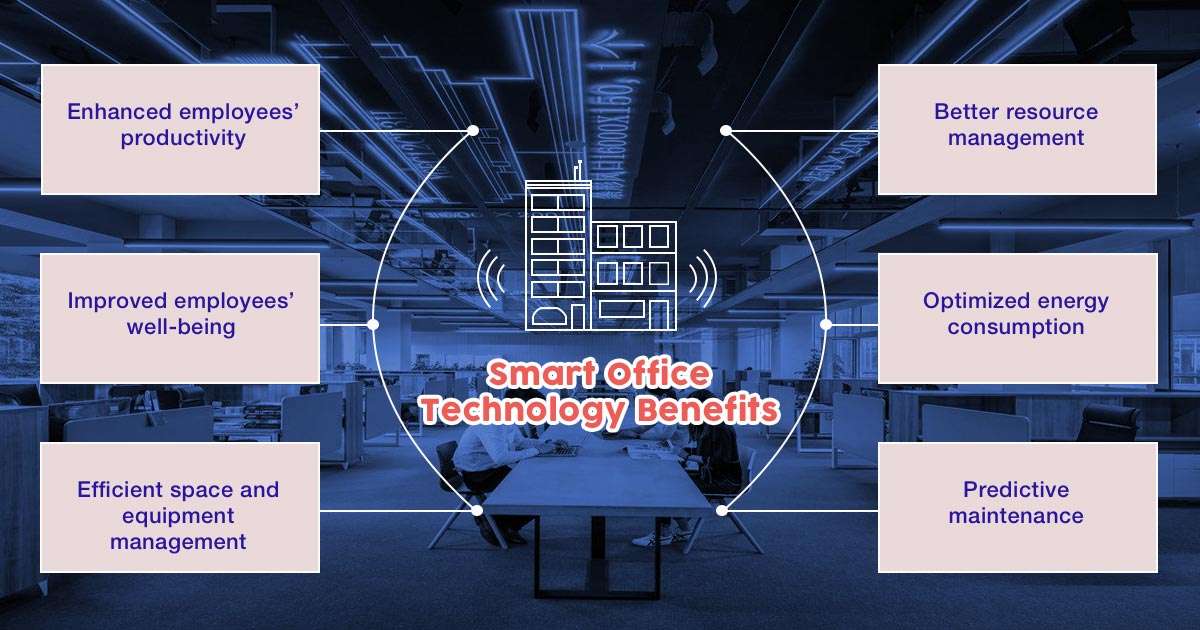The Transformational Impact of Smart Office Technology on Workspaces

In the age of digital transformation, ‘smart’ has become a buzzword that signifies connectivity, automation, and efficiency.
But what exactly makes technology ‘smart’? Smart technology includes devices or systems that learn from their surroundings and adjust how they work to do better. They can decide what to do using special rules and information without people having to help them.
People have been thinking about smart technology for a long time. It started back in the 1960s when machines began doing jobs on their own in factories. As technology got better and easier to use, smart technology ideas started showing up in regular life.
Nowadays, smart technology has changed almost everything we do. We have smart homes with lights, furniture, and security systems that work on their own. In schools, we use smart tools like interactive whiteboards and special computer systems to help us learn better. Even in offices, things are getting ‘smart’. They use fancy technology to make work easier and better.
Having smart technology in offices brings lots of benefits. If you own a business, it can help you make things run smoother. If you manage an office, it can help you use things like space and equipment better. And if you work in an office, it can make your job easier and more enjoyable. Smart technology in offices can really change the game!
The Top 8 Benefits of Smart Office Technology
If you want to know more about smart office technology, check out our list of the top 8 benefits. These benefits show how smart office technology can change your workspace for the better.
1. Improved Communication
Smart technologies like interactive whiteboards and digital signage help share information better. They let people work together in real time during meetings, which makes them more interesting and useful. For example, interactive whiteboards let team members share ideas, write on shared documents, and show data visually. Digital signage can show company news and important numbers, or even celebrate when employees do something great. This helps everyone know what’s going on and feel like they’re part of the team at the office.
2. Increased Productivity
Alexa for Business and other AI assistants can take care of tedious tasks, freeing up staff members to concentrate on more crucial tasks. For instance, using voice commands, employees can schedule meetings, set reminders, or even control office equipment. These assistants can also integrate with various business applications, enabling employees to access important information quickly. Automated task management systems further increase productivity by streamlining workflows and improving project tracking.
3. Enhanced Collaboration
Tools like Zoom and Microsoft Teams have changed the way teams collaborate. They make it simpler for remote teams to collaborate and communicate without interruption across various locations. These platforms support file sharing, screen sharing, and real-time editing of documents, enhancing the collaborative experience.
4. Optimized Space Utilization
Smart sensors and IoT devices can help businesses make the most of their office space. These devices can track how different areas in the office are used throughout the day, providing valuable insights into space utilization. The office environment can then be improved by using this information to make educated decisions about the layout and design.
5. Energy Efficiency
Smart devices can automate various aspects of office maintenance, leading to significant energy savings. Smart thermostats, for instance, can adjust the temperature based on occupancy and the time of day, saving energy. Similar to this, intelligent lighting controls can automatically turn off lights in areas that are not in use, further enhancing energy efficiency.
6. Better Security
Smart security systems provide enhanced protection for businesses. They offer features like real-time surveillance, motion detection, and access control, helping businesses safeguard their assets. Additionally, these systems can send alerts in case of any security breaches, enabling a quick response to potential threats.
7. Data-Driven Decisions
The data generated by smart devices can guide business decisions. This information can shed light on many business-related issues, including employee productivity and energy use. Businesses can identify trends, make predictions, and develop successful strategies by analyzing this data.
8. Employee Satisfaction
Employee satisfaction can rise as a result of using smart technology to create a more cozy and adaptable work environment. For instance, smart desks can adjust their height based on the user’s preference, improving ergonomics. Similarly, hot-desking solutions allow employees to choose where they work, promoting flexibility and autonomy.
Checklist When Planning Your Smart Office Upgrade
Upgrading your office to integrate smart technology can be a transformative move, but it does require careful planning. Here is a checklist to help you with the procedure:
Define Your Goals
Clearly articulate why you want to upgrade to smart office technology. Is the goal to raise energy effectiveness, security, or any combination of the three? Setting priorities and making wise decisions will be easier if your goals are clear.
Assess Your Current Technology
Evaluate the technologies currently in use in your office. What works well? What needs improvement or replacement? This assessment will help you identify gaps and opportunities for the integration of smart technologies.
Identify Suitable Smart Technologies
Based on your goals and current technology assessment, identify the smart technologies that would best meet your needs. They might include intelligent sensors and Internet of Things (IoT) gadgets, as well as task management and AI assistants.
Budget Planning
Upgrading to smart technology is an investment. Determine your budget for this project. Consider both the upfront costs of the technology and the potential long-term savings it could bring, such as reduced energy costs.
Choose Reliable Vendors
Research and select vendors who offer high-quality smart office technologies. Consider working with vendors who have solid customer ratings, dependable customer service, and a track record.
Develop an Implementation Plan
Determine the timing and method for implementing each technology. To reduce disruptions, take into account how these changes will affect daily operations and make plans accordingly.
Staff Training
Ensure your staff is trained to use the new technologies. This might involve workshops, online training sessions, or one-on-one coaching. Also, consider appointing a tech liaison within your team – someone who understands the technology well and can help others.
Data Security Measures
With the integration of smart technology comes increased data, which needs to be protected. Put in place strong data security measures and make sure data privacy laws are followed.
Continual Assessment and Adjustment
Once the new technologies are in place, continually assess their performance. Are they meeting your goals? What could be improved? Utilize these insights to change your tactics and maximize your smart office equipment.
Future-proof Your Office
Technology advances very quickly. Select technological solutions that can expand along with your company. Additionally, to stay on top of the curve, keep an eye on new developments in office technology.
Maximizing Productivity with Smart Office Tech
Using smart office technology can completely change how your workspace functions, bringing lots of benefits. It can make communication and working together better, help people work more, use space better, keep things safe, make decisions based on data, and make employees happier.
But it’s important to think carefully about how you do this upgrade. You need to think about what you need and what you want to achieve. Planning carefully will help the change happen smoothly and make sure your workspace is used well. Remember, the future office will be smart, and getting these technologies now can help your company do well in the future.

